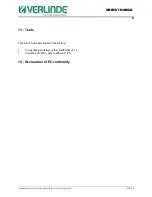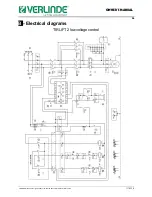
OWNER’S MANUAL
30
VERLINDE reserves the right to alter or amend the above information without notice
11/2018
12 - Operating faults
If you have followed the instructions for assembly and use, any incidents that do occur should be
minor.
The following instructions will help you resolve any faults quickly.
Fault
Possible cause
Solution
The motor does not
start.
Power supply cut.
Check and correct the problem.
Check the emergency stop.
Brake not released
See "brake fault".
The contactor does not respond,
control fault.
Check the contactor control and
eliminate the fault.
Limit switch engaged.
Check the limit switch.
The motor does not
start or starts with
difficulty.
The voltage or frequency varies
considerably compared to the
setting
when starting.
Improve the mains conditions.
Check the cable sections.
The motor revs and
absorbs a lot of
current.
The brake is not released.
See "brake fault"
Faulty winding.
Take the motor to an approved
workshop for repair.
One supply phase missing.
Check the power supply.
The circuit breaker
is activated
instantly.
Short circuit in the power supply
cables.
Eliminate the short circuit.
Short circuit in the motor.
Have the fault corrected in an
approved workshop.
Power supply cables incorrectly
connected.
Correct the connection.
Motor earth fault.
Have the fault corrected in an
approved workshop.
Speed greatly
reduced when
loaded.
Voltage drop.
Increase the power supply cable
section.
Motor too hot
(temperature
measure)
Insufficient ventilation.
Clear the ventilation lanes.
Ambient temperature too high.
Respect the authorised temperature
range.
Bad contact in the power supply
cable (operates temporarily on 2
phases)
Eliminate the bad contact.
Circuit breaker activated.
Bad contact in the relays.
Service factor exceeded (S1 to
S10, DIN 57530), e.g. because start
speed is too high.
Adapt the service factor to the
prescribed conditions; if necessary,
call a specialist to determine the type
of motor.
Drive system too
noisy
Rotating parts vibrate.
Check the balances, eliminate the
cause of the vibrations.
Foreign bodies in the ventilation
lanes.
Clean the ventilation lanes.
Brake not released
Max. air gap exceeded due to worn
lagging.
Measure and if necessary adjust the
air gap.
The motor does not
brake.
Incorrect air gap.
Measure and if necessary adjust the
air gap.
Brake lagging totally worn.
Replace the entire lagging retainer.








































